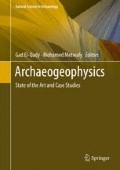Abstract
There is no doubt that one of the most difficult challenges facing the monument conservator is how to put a plan for conservation?, What is the criteria that control the success of such plan?.
Without conservation process, archaeological monuments subjected to various distractive factors, caused to loss a part of our cultural heritage. Conservation plan depends on some key stages, such as; registration and documentation process, collecting data (investigation and analysis), analyzing data, interpretation and diagnosis, design conservation plan.
A specialist team must cooperate for putting conservation plan, conservator is a coordinator who collects data from different specializations to be used for conservation plan. In the end we can say that the correct conservation plan help saving monument object, and vice versa.
Access this chapter
Tax calculation will be finalised at checkout
Purchases are for personal use only
References
Adams AE, Mackenzie WS, Guilford C (1988) Atlas of sedimentary rocks under the microscope. Longman Scientific & Technical, England, pp 19–25
Al-Anssary A, Abo Al-Hassan H (2005) Al-Ulla we Mada’n Salih (Al-Hijr). Dar Al-Qawafil, Riyadh, pp 32–33. (In Arabic language)
Al-Faqeer B (2006) Al-Syaha fe Mohafzet Al-Ulla. King Saud University, University Press, Riyadh, pp 55–58. (In Arabic language)
Ali H, Saleh M, Poksinska M (2002) The use of polarized microscope in the study of the brick, mortar and plaster used in Al-Foustat houses, Old Cairo, Egypt. Conference and workshop on conservation and restoration, Faculty of Fine Arts, Minia Univ, April 2002, pp 1–10
Al-Zahrani A (2006) The destructive factors of archaeological sites: Dadan site – Al-Ulla. Deliberations of Seventh Annual Scientific Meeting of the Society of History and Antiquities, Gulf Council Countries, Manama – Kingdom of Bahrain, 20–23 March 1427/April 18–21,.2006, pp 515–557. (In Arabic language)
Al-Zahrani A (2009) Studying of building materials used in Dadan site, Al-Ulla, Saudi Arabia. Deliberations tenth annual scientific meeting of the Society for History and Antiquities in the Gulf Council Countries, Abu Dhabi – United Arab Emirates, 24–26 April 2009, pp 243–277. (In Arabic language)
Al-Zahrani A, Saleh M (2011) The preliminary report of restoration and conservation work of Dadan Site (Khraibeh) and Qarh (Al-Mabbiayat) Province of Al-Ulla Seventh Season 2010–2011 AD. King Saud University, College of Tourism and Antiquities, Department of Heritage Resources Management and Tour Guidance, Riyadh. (unpublished). (In Arabic language)
Anders GN, Tronner K (1991) Stone weathering, air pollution effects evidenced by chemical analysis. Central Board of National Antiquities, Stockholm, pp 13–17
Ashurst J (2007) Conservation of ruins. Elsevier Limited, Amsterdam, pp 3–11
Barry R (1999) The construction of buildings, vol 1, 7th edn. Blackwell Science, Paris, pp 119–137
Ferretti M (1993) Scientific investigations of works of art. ICCROM, Rome, pp 39–46
Fitzner B, Heinrichs K, La Bouchardiere D (2000) Damage index for stone monuments. In: Galan E, Zezza F (ed) Protection and conservation of the cultural heritage of the Mediterranean cities. Proceedings of the 5th international symposium on the conservation of monuments in the Mediterranean Basin, Sevilla, Spain, 5–8 April 2000, pp 315–326
Folk LR (1980) Petrology of sedimentary rocks. Hemphill Publishing, Austin, TX, pp 203–272
Ghoniem M (2011) The characterization of a corroded Egyptian bronze statue and a study of the degradation phenomena. Int J Conserv Sci 2(2):95–108
Jain AK, Punmia BC, Jain AK (2005) Soil mechanics and foundations. Firewall Media, pp 111–129
Lamaee S (2005) Principles of monuments restoration, restoration and preservation of architectural heritage – Specialized training course, Handbook of research – Supreme Commission for the development of Riyadh city. pp 6–7
Liritzis I, Sideris C, Vafiadou A, Mitsis J (2008) Mineralogical, petrological and radioactivity aspects of some building material form Egyptian Old Kingdom monuments. J Cult Heritage 9:1–13
Mackenzie WS, Adams AE (1998) A colour atlas of rocks and minerals in thin section. Manson Publishing, London, pp 132–137
Maravelaki-Kalaitzaki P, Bakolas A, Moropoulou A (2003) Physico-chemical study of Cretan ancient mortars. Cem Concr Res 33:651–666
Pavlíková M, Pavlík Z, Keppert M, Černý R (2011) Salt transport and storage parameters of renovation plasters and their possible effects on restored buildings walls. Constr Build Mater 25:1205–1212
Petzet M (1999) Principles of monument conservation. J Ger Natl Commit XXX, ICOMOS, p 33
Saleh M (2005) The problems of soluble salts at The Old Cairo Walls (1176–1193 A.D.), Egypt. Conference and workshop on conservation and restoration, Faculty of Fine Arts, Minia Univ, March 2005, pp 57–69
Saleh M Loosing and preserving the ruins of mud-brick walls: a case study, Faculty of Archaeology Excavation – Cairo University – Saqqara. Adumatu XXII, August 1431–July 2010, pp 29–44. (In Arabic language)
Saleh M Restoration and conservation of Chapel
 Faculty of Archaeology Excavation – Cairo University at Saqqara’. J King Saud Univ, Tourism and Antiquities XXIII, 1, January 2011–1432, pp 1–16. (In Arabic language)
Faculty of Archaeology Excavation – Cairo University at Saqqara’. J King Saud Univ, Tourism and Antiquities XXIII, 1, January 2011–1432, pp 1–16. (In Arabic language)Saleh M (January–March 2013) Characterization of Qarh’s wall plasters, Al-Ulla, Saudi Arabia: a case study. Int J Conserv Sci 4(1):65–80
Uda M (2004) In situ characterization of ancient plaster and pigments on tomb walls in Egypt using energy dispersive X-ray diffraction and fluorescence. Nucl Instr Methods Phys Res B 226:75–82
Author information
Authors and Affiliations
Editor information
Editors and Affiliations
Rights and permissions
Copyright information
© 2019 Springer International Publishing AG, part of Springer Nature
About this chapter
Cite this chapter
Saleh, M.M. (2019). What Is Conservation Plan?. In: El-Qady, G., Metwaly, M. (eds) Archaeogeophysics. Natural Science in Archaeology. Springer, Cham. https://doi.org/10.1007/978-3-319-78861-6_14
Download citation
DOI: https://doi.org/10.1007/978-3-319-78861-6_14
Published:
Publisher Name: Springer, Cham
Print ISBN: 978-3-319-78860-9
Online ISBN: 978-3-319-78861-6
eBook Packages: Social SciencesSocial Sciences (R0)


 Faculty of Archaeology Excavation – Cairo University at Saqqara’. J King Saud Univ, Tourism and Antiquities XXIII, 1, January 2011–1432, pp 1–16. (In Arabic language)
Faculty of Archaeology Excavation – Cairo University at Saqqara’. J King Saud Univ, Tourism and Antiquities XXIII, 1, January 2011–1432, pp 1–16. (In Arabic language)